8.8 Biodiversity contributes to the productivity and stability of fisheries

What mechanisms may connect diversity among aquatic primary producers to higher diversity among aquatic consumers?
Many vital services by marine and freshwater ecosystems, such as higher production and stability of aquatic resources, are sustained by biodiversity (Figure 8.25). One explanation for higher production is that diverse ecosystems make more efficient use of nutrients and light (Figure 8.26). In addition, higher genetic and species diversity leads to higher stability in the face of disturbance and faster recovery following disturbance. For instance, genetic diversity in populations of seagrass, Zostera marina, is associated with greater resistance to disturbance by grazers and faster recovery following heat-induced mortality (Figure 8.27). When the seagrass is healthy, so, too, are the fisheries that depend on the seagrass. The fact that diverse ecosystems have high productivity and buffer communities from disturbance is a key reason they provide important ecosystem services to humans. Biodiverse and stable ecosystems with complex physical structure sustain higher species and population numbers, which humans can harvest indefinitely with sustainable fisheries management.
AQUATIC ECOSYSTEM SERVICES
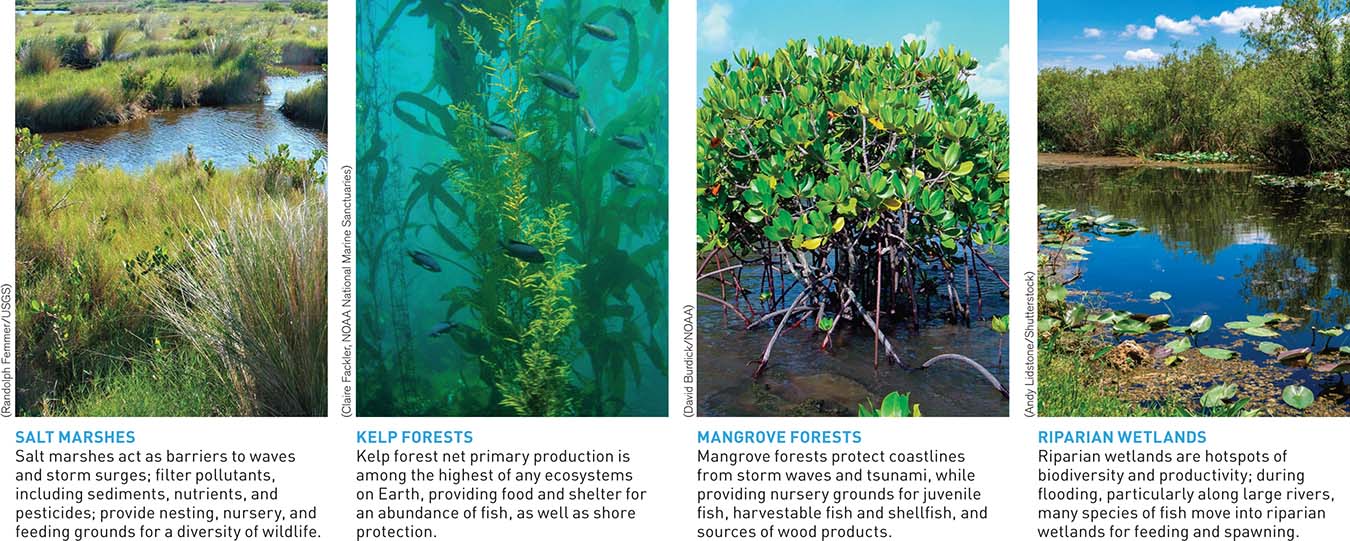
FIGURE 8.25 Biodiversity helps sustain economically valuable services provided by aquatic ecosystems, including salt marshes, kelp forests, mangrove forests, and riparian wetlands.
(Randolph Femmer/USGS) (Claire Fackler, NOAA National Marine Sanctuaries) (David Burdick/NOAA) (Andy Lidstone/Shutterstock)
INFLUENCE OF MARINE PRIMARY PRODUCER DIVERSITY ON ECOSYSTEM FUNCTION
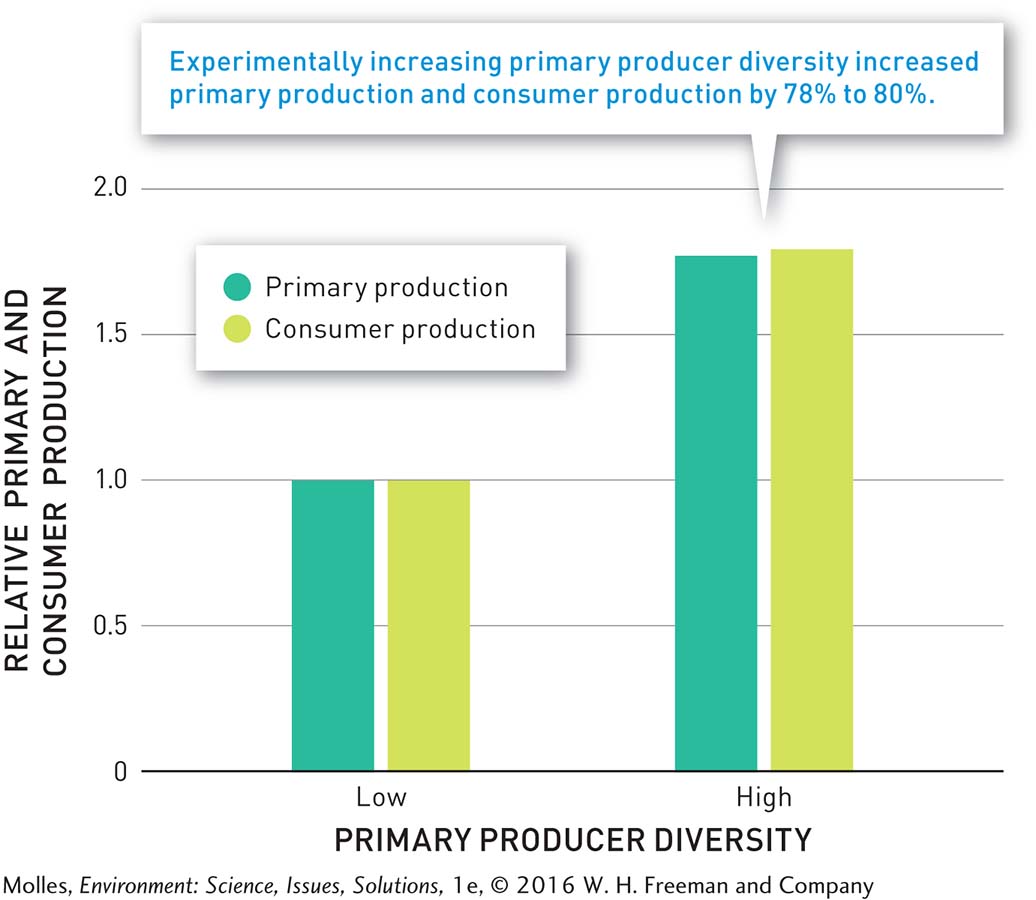
FIGURE 8.26 A survey of several experimental studies, which manipulated primary producer diversity, demonstrated the strong positive effect of primary producer diversity on primary and consumer production. (Data from Worm et al., 2006)
GENETIC DIVERSITY AND ECOSYSTEM STABILITY
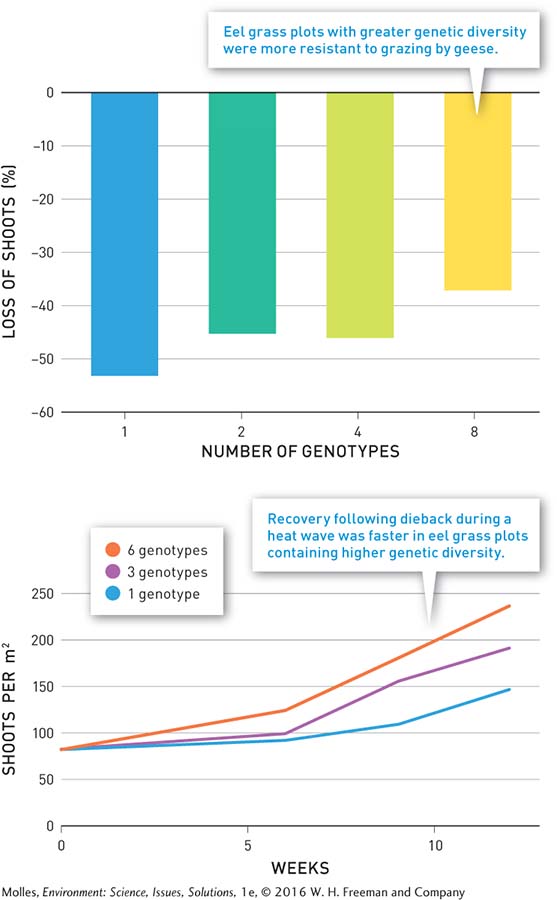
FIGURE 8.27 Plots of eel grass, Zostera marina, containing more genotypes lost fewer shoots to grazing geese, indicating higher resistance to this form of disturbance. (Data from Hughes and Stachowicz, 2004) Eel grass plots containing more genotypes also recovered more rapidly following heat-related mortality, indicating higher resilience following disturbance. (Data from Reusch et al., 2005)
Biodiversity and Bristol Bay Sockeye Salmon
The fishery for sockeye salmon (Oncorhynchus nerka) around Bristol Bay, Alaska, has produced high-quality dietary protein and has brought a stable income to the communities around Bristol Bay for more than a century (Figure 8.28). How has this fishery been sustained, while many other fisheries around the world have collapsed? One of the keys to its sustainability appears to be biodiversity at several levels.
SOCKEYE SALMON, ONCORHYNCHUS NERKA, AN IMPORTANT AQUATIC RESOURCE
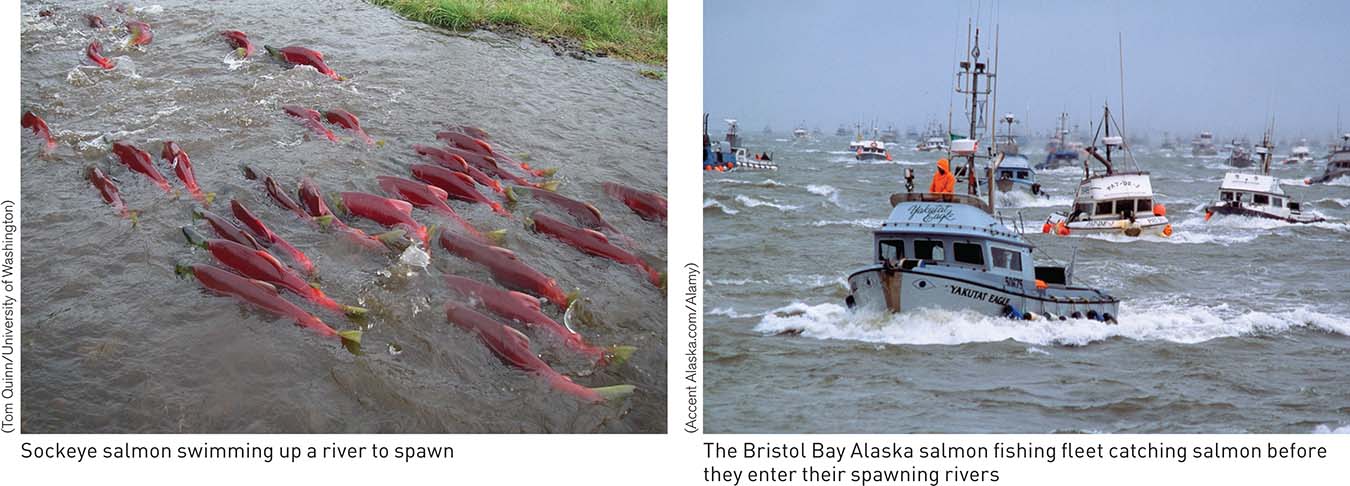
FIGURE 8.28 Sockeye salmon, Oncorhynchus nerka, are native to the North Pacific region, where they spawn in river and lake ecosystems from the Klamath River of California and Oregon to Alaska, Siberia, and the island of Hokkaido, Japan. The species is an important source of income and nutrition to local communities throughout its range. For example, in recent years the sockeye salmon fishery of Bristol Bay, Alaska (shown in action here), alone has been valued at over $100 million annually.
(Tom Quinn/University of Washington) (Accent Alaska.com/Alamy)
The high level of biodiversity in the Bristol Bay sockeye salmon system is due largely to the diversity of its environment. The cool summers and mild winters of a maritime climate, as well as the more variable continental climate, mark the area, which includes a large number and diversity of river and lake ecosystems. Overlaying climatic diversity with ecosystem diversity produces another source of biodiversity that arises from the great variety of spawning environments around the bay, including creeks, spring-fed ponds, large rivers, lakeshore beaches, and beaches around islands. As a result of this environmental complexity, the Bristol Bay sockeye fishery includes several hundred distinctive populations, spawning in hundreds of different places. Because adult salmon return to spawn in the streams where they hatched from eggs, they are adapted to those specific stream conditions and, consequently, populations associated with different spawning streams and habitats accumulate genetic differences over time. Therefore, the physical diversity of the Bristol Bay ecosystem produces great genetic diversity among the sockeye salmon populations (Figure 8.29).
BIODIVERSITY AND THE BRISTOL BAY SALMON FISHERY
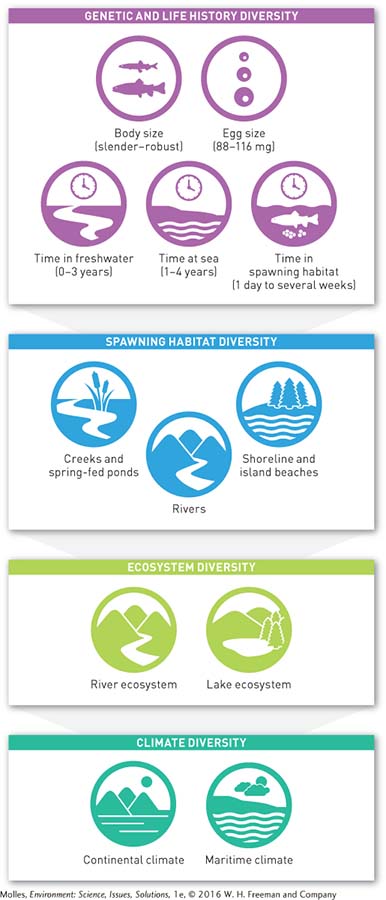
FIGURE 8.29 Many factors contribute to biodiversity in the Bristol Bay sockeye salmon fishery, including climatic diversity, ecosystem diversity, spawning habitat diversity, and genetic and life history diversity. (Data from Hilborn et al., 2003)

How is diversity in physical factors likely contributing to diversity in salmon populations in the Bristol Bay fishery?
Ecosystem and genetic diversity have contributed to the stability of Bristol Bay sockeye salmon fisheries. As shown in Figure 8.30, very high catch levels have been maintained for more than a century. This stability has been maintained even in the face of climatic variation resulting from ocean conditions that produce good and bad years for salmon in their marine life phase. The diversity in sockeye populations has been a critical element to their persistence at the population level, as local environmental changes that might negatively affect one subpopulation might not affect others. For example, notice in Figure 8.30 how the Egegik population of salmon, which contributed very little to the fishery in the early 1900s, was the dominant source of salmon caught after 1990.
HISTORY OF SOCKEYE SALMON CATCHES IN THREE MAJOR FISHING AREAS OF BRISTOL BAY
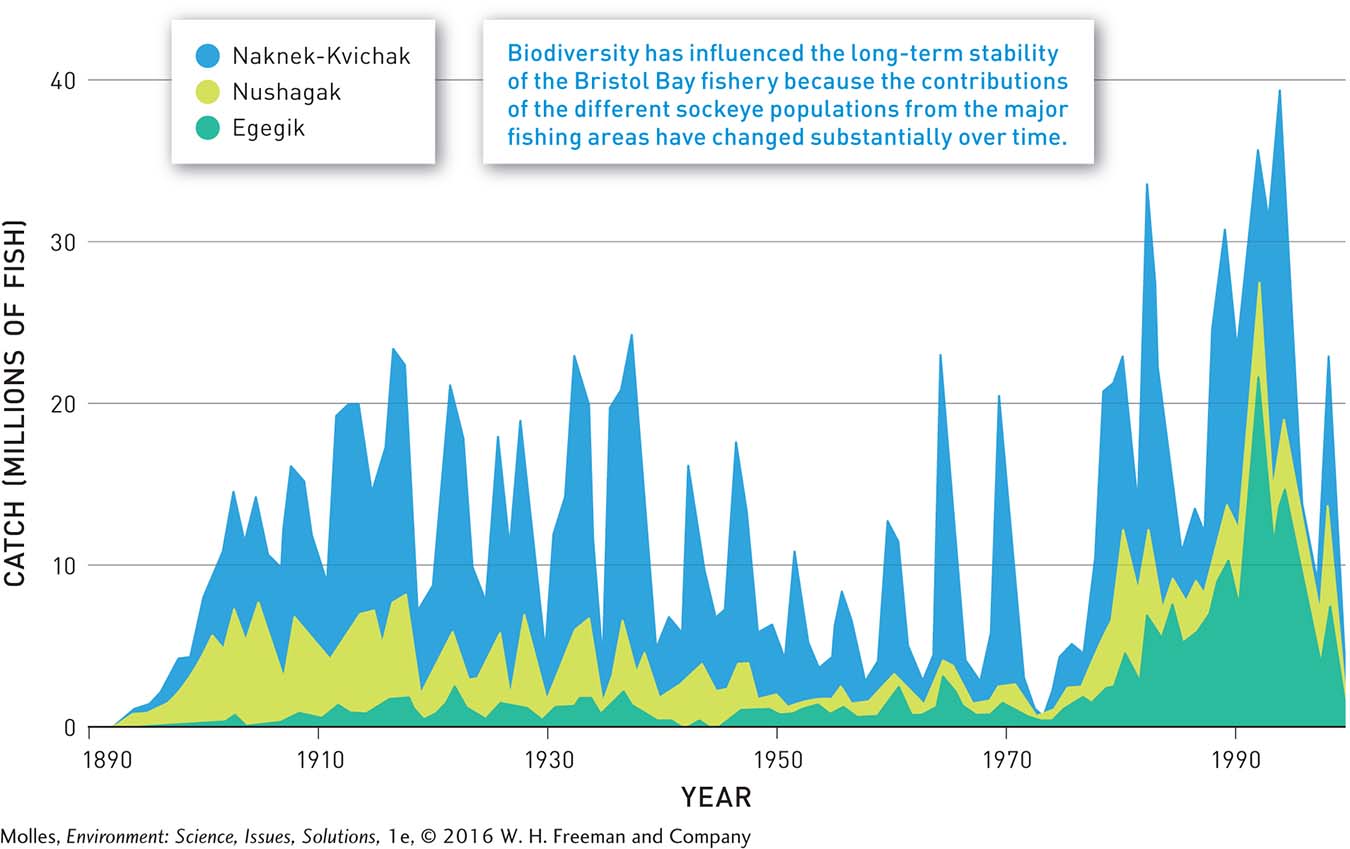
FIGURE 8.30 The populations contributing to the Bristol Bay sockeye salmon fishery have varied in importance over time. (Data from Hilborn et al., 2003)

How might a proposed mine in the Bristol Bay watershed alter the physical environment and how might those environmental consequences affect sockeye salmon?
An analysis published in the scientific journal Nature in 2010 concluded that the diversity of the Bristol Bay system more than doubles the stability of its salmon yields, compared with what they would be if the fishery consisted of a single salmon population. In addition, a fishery depending on a single salmon population would need to be closed, due to low numbers of returning salmon, 10 times more frequently. Of course, even the very diverse Bristol Bay fishery could not be sustained in the absence of sound management.
Marine Reserves Can Benefit Fish and Fishers

How can excluding fishing from some areas of the marine environment ultimately increase the economic viability of the fishery?
ecosystem-based management An approach to management of natural resources that considers the entire ecosystem; a departure from earlier, single-species approaches to natural resource management.
marine protected area (marine reserve) An area in the marine environment where resource use is restricted to help sustain fish and shellfish populations, protect entire marine ecosystems, and safeguard marine ecosystem services.
Fisheries scientists increasingly recognize that optimal management strategies include information on the whole ecosystem in which commercially important fish populations live and on which they depend. This shift in focus acknowledges how natural systems provide ecosystem services and has given rise to ecosystem-based management of fisheries. This approach to management of natural resources takes into account the entire ecosystem. One of the products of ecosystem-level thinking about fisheries problems has been growing interest in the use of marine protected areas, or marine reserves, where resource use is restricted to help sustain fisheries stocks and to protect entire marine ecosystems and safeguard their many services. Most marine protected areas are designated as permanent no-take zones, but others are seasonally closed during key times of year when fish congregate to spawn.
Benjamin Halpern of the University of California at Santa Barbara examined the influence of marine protected areas on the density, biomass, size, and diversity of marine organisms. He found that marine protected areas consistently support a higher density and biomass of fish (Figure 8.31). In addition, the fish in marine protected areas are larger and more diverse than in surrounding unprotected areas or than they were before the protected area was established. Furthermore, the growing populations within marine protected areas in the northeastern Atlantic have been shown to “spill over” to surrounding fishing grounds, improving fishing success and fulfilling their promise.
CABO PULMO, BAJA CALIFORNIA: A DRAMATIC EXAMPLE OF RECOVERY IN A MARINE PROTECTED AREA

FIGURE 8.31 With protection of Cabo Pulmo, the only coral reef ecosystem in the Gulf of California, fish populations have rapidly surpassed the numbers in nearby areas subject to continued fishing (biomass has increased nearly fivefold within 10 years of protection).
(Leonardo Gonzalez/Shutterstock)
In a study sponsored by The Nature Conservancy, researchers found that recently established marine protected areas had far-reaching effects on communities in Fiji, the Solomon Islands, Indonesia, and the Philippines. As in other regions, fish populations and sizes have grown in these marine protected areas, and the catch has increased in the surrounding fishing grounds. These changes have reduced poverty both directly and indirectly (Figure 8.32). In the Fijian community studied, monthly income from fishing has doubled since the establishment of the marine protected area. While the focal community in Indonesia did not benefit markedly from improved fishing, the marine protected areas have benefited them indirectly. The marine reserves have attracted more tourists, and many local people have taken jobs in the tourism industry, where they earn 2½ times the income of fishers. In addition, by selling produce to resorts that draw tourists to the reefs for snorkeling, local farmers have found a more stable market for their crops and have increased their incomes. The island communities where marine protected areas were established also realized significant social benefits, including better governance, improved diet, and better sanitation.
MARINE PROTECTED AREAS OF THE UNITED STATES

FIGURE 8.32 The number and expanse of marine protected areas within United States territorial waters have grown rapidly.
(Shane Myers Photography/Shutterstock)
Think About It
How are the “services” of marine and freshwater ecosystems connected to biodiversity?
What factors contribute to the biodiversity of the Bristol Bay salmon fishery?
How might Elinor Ostrom’s ideas for sustainable management of common-pool resources by local communities be used to manage marine protected areas (see Figure 2.25, page 55)?











